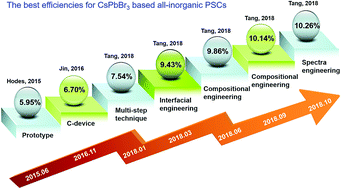All-inorganic CsPbBr3 perovskite solar cell with 10.26% efficiency by spectra engineering†
Abstract
All-inorganic perovskite solar cells (PSCs) are regarded as a promising solution to improve the environmental tolerance of emerging photovoltaics; however, the narrow light response (<550 nm) of cesium lead bromide (CsPbBr3) perovskites markedly lowers their power conversion efficiency (PCE). We present here the proof-of-concept for mixed light harvester prepared from CsPbBr3 halide and an inorganic SnS:ZnS photoactive layer (PAL) to broaden the spectral absorption from 550 nm to 700 nm. Owing to the reduced surface defects on the perovskite film, improved charge extraction, and broadened light response, the all-inorganic PSC with the structure of FTO/c-TiO2/m-TiO2/CsPb0.97Tb0.03Br3/SnS:ZnS/NiOx/carbon delivered a short-circuit current density of 8.21 mA cm−2, an open-circuit voltage of 1.57 V, a fill factor of 79.6%, and a champion PCE as high as 10.26% under one sun illumination. The preliminary results also suggest that these devices are relatively stable under persistent conditions of 80% RH or temperature of 80 °C in air. The proof-of-concept for mixed perovskite/PAL absorber provides new opportunities for a wide-spectral response and therefore markedly increased the PCE outputs.



 Please wait while we load your content...
Please wait while we load your content...